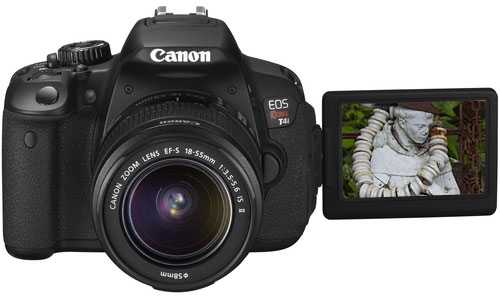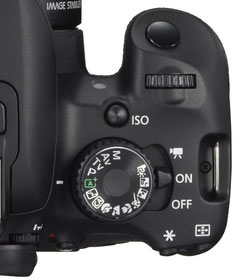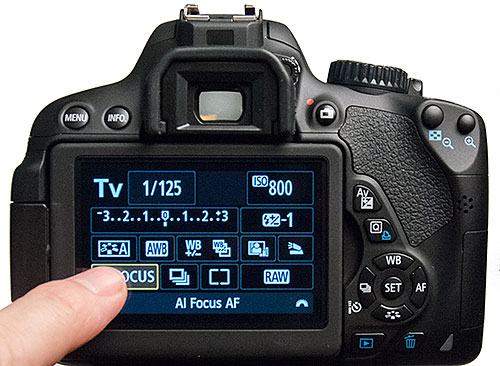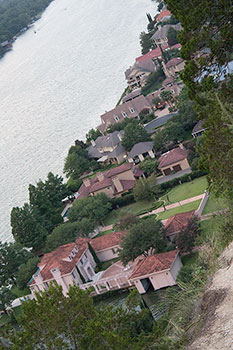Best DSLR Cameras under $1000
- The Shootout
- Sony a65 Review
- Canon T4i Review
- Canon T3i Review
- Nikon D5100 Review
- Nikon D3200 Review
Canon T4i/650D Review
The headline item on the Canon T4i is that its 3" LCD viewscreen is touch sensitive. And this feature deserves that honor, not solely because the T4i is the first DSLR to offer it, but because the touchscreen works so well, making the camera easier and more fun to use.
The Canon designers also attempted to solve one of the nagging problems with Live View, the speed and quality of Contrast Detection autofocus. The details will be discussed below. For now, let's say that they weren't totally successful, which is one of the reasons that the Sony a65 with its translucent lens system is still rated over the T4i.
As an upgrade to the T3i, Canon has added enough enhancements to the T4i to make it a compelling option if you are just buying your first Canon mid-range DSLR. If you already have the T3i, then the decision to jump to the new kid is less clear, especially if you are not enamored with touchscreens.
If you do make the leap from 3 to 4, you should feel quite comfortable with the layout and handling of the T4i. The camera bodies are very, very similar.
And even though the sensor size is the same for both cameras, Canon has reengineered the 18MP CMOS sensor and added the more powerful Digic 5 processor, which gives the T4i an edge in image quality over the T3i.
At this PhotoScope link, you can judge for yourself about the image quality differences between the two Canons. Both are set at ISO 200. Try various ISOs to see if one camera performs better than the other.

What's Hot about the Canon T4i
- Excellent capacitive touchscreen
- 18MP CMOS APS-C sensor
- Increased ISO range up to 12800 standard / 25600 expanded
- Wide selection of lenses, including two new stepper motor (STM) models
- Fully articulating screen
- 5 fps continuous shooting
- 1080p video at multiple frame rates with audio level meters
- Input for external microphone and two integrated microphones
- Wireless flash control
What's Not So Caliente about the Canon T4i
- Integrated phase detection AF for live view and video is not stellar
- Touchscreen can activate unintended features if you are not careful
- Notable noise at ISOs over 1600
- No integrated image stabilization, (on the lens only)
- No Panorama or 3D shooting modes
- No built-in GPS
Design
Canon made the wise choice to make the first DSLR touchscreen the capacitive type, the same used in the smartphones that a whole generation has grown up with. Indeed, if you are on a first name basis with the iPhone, the T4i's multi-touch screen will feel natural. It's responsive, which makes navigating through the menus quite fast.

You can change almost any setting from the touchscreen except for the Exposure Modes like Aperture or Shutter Priority. For those, you must still manually rotate the Mode dial at the top of the body.
Also notice, that the On/Off lever surrounding the Mode dial now includes a Movie position. When chosen,the camera automatically switches to Live View. To start recording video, you push the Live View button to the right of the viewfinder.
Other than those mode controls, any adjustments that you can make manually, you can do on the touch screen. Which is a double edged sword because if you are not careful, with an idle brush of the hand, you can mistakenly change a setting while you are not looking.
Luckily, if you have wandering fingers, you can turn off the touch screen feature, though you have to dig into the menu to do it. Preferably, there would be a little On/Off lever that you could quickly switch.
In Live View, you can also touch the screen to release the shutter or pick a spot to focus on. Both functions work like promised, though for some old codgers, punching a screen to snap a photo just doesn't seem right.
Of course, to many whippersnappers, touchscreens are digital extensions to their flesh and bone digits and act as portals to the world. With perhaps a billion smartphones on Earth, it's surprising that it took this long for touchscreens to show up on a DSLR, though they are becoming more and more common on mirrorless, compact system cameras.

On a more fundamental level, Canon has designed what they call a "hybrid" CMOS sensor for the T4i. The engineers have added pixels on to the sensor that can perform Phase Detection autofocusing tasks.
With DSLRs, autofocusing is normally done by reflecting the light coming through the lens off the mirror and on to a dedicated Phase Detection system, which is fast and accurate.
The problem with this system happens when the mirror is locked up in Live View and the light is cut off from the Phase Detection sensor and goes directly to the image sensor. Commonly, the image sensor could only focus with Contrast Detection, which can be accurate but often takes longer to find the focus.
The T4i's hybrid sensor uses the Phase Detection pixels to speed up the calculations on how far the subject is from the camera and the Contrast Detection finishes the job. In theory, it sounds like a good solution. In practice, I found that autofocusing when shooting video still entailed too much hunting. And though it may be faster than with a camera like the T3i, autofocusing still wasn't fast enough.
Another autofocus issue when shooting video is the sound made when the lens is adjusting the focus. The clicking noise is very noticeable if you are using the internal stereo microphones. You can hear it on the clip above.
To solve this problem, Canon introduced two new lenses, the EF 40mm f/2.8 STM and the EF-S 18-135mm f/3.5-5.6 IS STM. The STM acronym stands for stepper motor, which is an internal system that quietly autofocuses the lens. Neither was tested for this review.
Image Quality

The image quality produced by the Canon T4i'a new image sensor combined with the Digic 5 image processor is very good as you would expect from a mid-range DSLR. The 18MP images make wonderful 8 by 10 prints with plenty of pixels left over for some creative cropping.
In our test shots, at ISOs of 1600 and over, the image begins losing detail while controlling noise. All things considered, it performs quite well.
The photo on the right was shot at ISO 6400, f/6.3, 1/250 sec., 18-55 kit lens @55mm. It was taken after sunset. If you click the image, you will see a full scale crop. The noise is evident, but no noise reduction was applied to the original RAW file.
To reduce the noise, you could shoot JPEGs and have the camera apply noise reduction internally. For more control, you can capture RAW files and post process the images.
Pixel peeping 100% images can be informative, but often this up-close and hypercritical practice can be misleading when dealing with common everyday usage. For example, click here to see the same ISO6400 image, (uncropped and with no noise reduction applied), reduced to a more Internet friendly size.
This PhotoScope link compares the T4i with itself at different ISOs. To begin, if you click the PhotoScope link, the image on the left has the ISO at 100, the one on the right is ISO 6400. No external noise reduction has been applied. If you roll the Scope over the blue and purple label on the olive jar, you can clearly see the noise in the right image. Cycle through some of the other ISO settings to judge how the T4i fares.
As for the T4i's video quality, it's good. It still is prone to aliasing and moire artifacts. I still prefer the Sony a65's ability to use the electronic viewfinder when recording video. But the T4i's touchscreen could be valuable to quickly tap on a focus point, especially if the camera is on a tripod.
Features
For many, the Canon T4i's touchscreen more than makes up for any missing features like Panorama or 3D shooting modes.
By turning the Mode dial, you can access an HDR (High Dynamic Range) function called HDR Backlight Control, which combines three shots at three exposures to improve highlight and shadow detail.
The Mode dial also offers presets like Portrait, Landscape, Close-up and Sports. Or if you wish to let the camera take over all the thinking, you can choose the A+ icon for Scene Intelligent Auto, which is a fully automatic mode that detects the scene and adjusts all of the settings. I can understand the practicality of this mode, but why buy a $1000 DSLR if you are removing yourself from the creative process?
Though not sports photography speed, the five frames per second continuous shooting rate is respectable for a camera at this price point.
With the introduction of a touchscreen, it's a bit surprising that Canon did not include other features that are common in smartphones like GPS and at least Wi-Fi connectivity.

Perhaps they are just saving those for the T5i or their first mirrorless compact system camera, which is rumored to be on the horizon.
Verdict
If not for the Sony a65, this new Canon T4i would occupy our 2 Camera Guys top spot for mid-range DSLRs under $1000.
The image quality is solid and with all the manual controls, old time photographers should feel right at home with the T4i.
For those looking to move up from the cameras in smartphones, the T4i's touchscreen is the icing on the cake, which no other DSLR can offer.
Canon T4i Photo Gallery
More about the Canon T4i
In This Shootout:
The Shootout
Sony a65 Review
Canon T4i Review
Canon T3i Review
Nikon D5100 Review
Nikon D3200 Review
Reader Comments(8 comments)
|
Posted Oct 10, 2013 8:31:16 PM
|
|
By Big Mike |
Post a Comment Alert Moderator |
|
Posted Nov 2, 2012 8:54:18 PM
|
|
By Kuro |
Post a Comment Alert Moderator |
|
Posted Oct 31, 2012 11:52:07 AM
|
|
By Peteralex |
Post a Comment Alert Moderator |
|
Posted Sep 2, 2012 7:49:54 PM
|
|
By krazi311 |
Post a Comment Alert Moderator |
|
Posted Aug 28, 2012 3:30:02 PM
|
|
By Dick De Jong |
Post a Comment Alert Moderator |
Suggesting lenses for others is always a tough call for reasons too long to list.
If you are interested in high quality and are ready to make the commitment, then Zeiss lenses are great choices, but they come at a premium price tag.
For example, the Sony 85mm F1.4 ZA Carl Zeiss Planar T* is a wonderful portrait prime lens. Of course, at $1600, it's almost twice the price of the a65 body alone. But good lenses can last through multiple generations of cameras.
|
Posted Aug 28, 2012 2:55:55 PM
|
|
By Dick De Jong |
Post a Comment Alert Moderator |
I've been shooting video for decades and I'm still not convinced that any of these DSLRs are the perfect solution for capturing video. (I listed many of those reasons in my article, Making Home Movies: http://www.2cameraguys.com/Making-Home-Movies-with-Digital-Cameras.htm)
With that said, I do not discount your preference of the T4i over the a65 when shooting video. I will say that if you plan to use autofocus with any of these cameras, then expect to capture segments of out of focus searching, which you will need to edit.
And if you want higher quality audio, then you will need to use an external microphone and ideally a good audio recorder.
I'll admit that I am still rating these cameras more for their still image abilities and less on their video. Accordingly, the Sony a65 is on the top of my list. But as I've said, the T4i is a very good camera, which you should enjoy.
|
Posted Aug 14, 2012 12:06:07 PM
|
|
By frazzywig |
Post a Comment Alert Moderator |
|
Posted Aug 9, 2012 6:53:25 PM
|
|
By Art |
Post a Comment Alert Moderator |






















